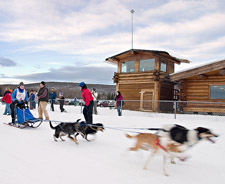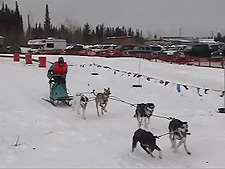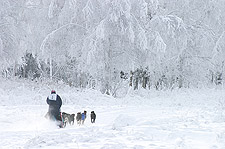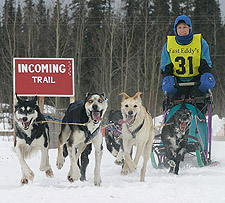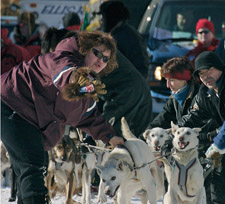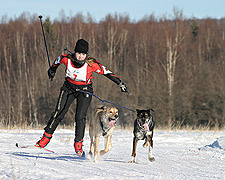Dog drivers in the fast lane
Andrea Swingley’s four-dog team leaves the start chute at the Jeff Studdert Racegrounds in Fairbanks, Alaska.
Jeff Conn’s eight-dog team rounds a curve during the Alaska Dog Mushers Association’s annual Gold Run at the Jeff Studdert Racegrounds.
Carol Kaynor and her team cross the finish line at the 2005 Tok Race of Champions in Tok, Alaska. (Video 4.8MB)
Jeff Conn and his eight-dog team head down the trail into the frosty forest during a race at the Jeff Studdert Racegrounds in Fairbanks, Alaska.
By Andrea Swingley, University Marketing and Publications
February 2007
The sound of excitedly barking dogs drowns out the announcers’ voices counting down. "Thirty seconds ... works at UAF ... has been running dogs since ..."
"Fifteen," a voice calmly states. Time to pick up the snow hook. Better hope that the brake and the people holding back the sled are enough to keep the team from starting prematurely.
"Five ... four ..." The dogs are screaming and lunging now...
"Three ... two ... " The sled holders start to lean back from the sled...
"One ... go!" The sled lurches forward as the team takes off. Suddenly all is quiet except for the soft sounds of my dogs breathing and the waxed plastic sled runners gliding across the trail. The race is on, but I’m just one of many UAF folks out on the trail.
Alaska’s official sport
Dog mushing is the state sport of Alaska. Many people are familiar with dog mushing because of the 1,150-mile Iditarod and 1,000-mile Yukon Quest sled dog races. But before these famous long-distance races, there were the shorter speed races like the Open North American Championship and the Anchorage Fur Rendezvous World Championship.
Shannon Erhart gives last-minute instructions for her daughter’s team at the start line of the 2006 Open North American Championship.
"To Alaskans, dog mushing and mushers used to be what Michael Jordan and all these famous sports figures are," says Shannon Erhart, who grew up mushing dogs in Alaska’s Interior. "Kids used to push sleds and say, "I’m George Attla’ and ’I’m Gareth Wright today’."
Erhart, a fiscal technician for UAF’s Interior-Aleutians Campus, her husband Curtis, daughter Carey, and sons Lester and Gareth are all continuing the family tradition of sled dog racing. "This is what my dad did. My sister did. Curtis’ dad did. Even Curtis’ grandfather raced in the North American back in the day," she explains. Erhart’s father is Gareth Wright and her sister is Roxy Wright, both of whom have won the Open North American and other major sprint races.
"We haven’t obtained our goal of winning the North American yet, so we’re still trying," Erhart adds. In recent years, Erhart has left the racing to Curtis and Carey in order to work full time at UAF, but she can still be seen helping her team leave the start chute at the races, and she gets calls for advice a couple of times a day when the others are out training. "I’m the glue," she says.
Shannon Erhart is just one example of a sprint musher associated with UAF. On almost any weekend from December through March, there’s a sprint race happening in the Fairbanks area. In some races nearly half of the competitors are UAF students, staff or faculty.
Sprint vs. distance
A sprint, or speed, race is shorter and faster than a distance race like the Iditarod. Teams generally race between three and 30 miles, and there are classes for different numbers of dogs. Most races held by the Alaska Dog Mushers Association in Fairbanks are limited class, which means there is a limit on the number of dogs in a team. There are generally four-, six-, and eight-dog sled competitions plus one-, two- and three-dog skijor competitions. Skijoring is similar to dog sledding, except that the musher is on skis instead of a sled while being pulled by dogs in harness. Open-class races like the Open North American allow mushers to take as many dogs as they are comfortable with, although generally teams consist of 12 to 22 dogs.
Ask sprint mushers why they run sprint and not distance, and usually their first reason is, "I like going fast." Some people don’t do well with sleep deprivation, a condition that often afflicts mushers during long-distance races. "I’m not the kind of person who can go for days without sleep and be very happy and then function efficiently," says Jeff Conn, an associate professor of agronomy with UAF’s School of Natural Resources and Agricultural Sciences.
A musher’s body can affect the mushing he or she does in other ways. Carol Kaynor, web and database coordinator for Alaska Sea Grant, says her small size and limited strength are a disadvantage if she wants to haul a heavy sled jam-packed with camping gear and dog food. But in the four-dog sprint class, where extra weight may slow the team, Kaynor’s build is a great advantage.
A skijorer is an integral part of the team and works just as hard as the dogs. Kriya Dunlap helps her two dogs down the trail.
Then there’s the cold. It’s not uncommon for temperatures along the Yukon Quest trail to drop to 40 below and winds to reach 100 miles per hour. "I don’t like to be too cold. I get cold easily," says Kriya Dunlap, a champion skijorer who is working on an interdisciplinary Ph.D. in nutrition through UAF’s Department of Chemistry and Biochemistry. Dunlap grew up with sled dogs in upstate New York, where her parents operated a kennel of 150-200 dogs. Dunlap raced her first dog team when she was four years old. In high school Dunlap took up crosscountry skiing and really got into it. A few years later, she discovered skijoring was the perfect combination of skiing and dogs.
"The best motivation to exercise is a hyper sled dog," adds Dunlap. She says her first dog would cry and whine and drive her crazy until she got out and ran him, which also meant running herself. Now skijoring is part of her lifestyle. It makes her feel good physically and mentally.
A balancing act
Jeff Conn’s first dog was littermate to a well-known distance dog, and he tried running distance. But the more he learned about how far you had to go and how much time it took, the more he could see distance wasn’t going to work in terms of having a job, too. "Dog mushing is a huge time commitment," Conn explains. "It’s a big juggling act with mushing and work and being a good family member. You really have to have an understanding partner and family to make it work."
Racing in the eight- and 10-dog classes is something Conn can afford the time to do, and do well, because it doesn’t need the many long practice runs required for distance mushing. Sprint mushers can often train after work and on weekends. Carol Kaynor takes advantage of flex time and scales back her work hours to three-quarter time during winter, although becoming a master’s degree student in creative writing has made training more of a challenge. But Kaynor persists, in part, because dog mushing is "a legitimate way to be crazy about dogs." An accommodating supervisor helps, too.
Kriya Dunlap has integrated her dogs into her lifestyle. The dogs go everywhere with her, partly so she can train during daylight hours. She has even incorporated her interest in sled dogs into her graduate studies at UAF. Her master’s research examined the effects of blueberries on antioxidant levels in working sled dogs. Now she is researching diet quality and contaminant load in subsistence-fed sled dogs along the Yukon River.
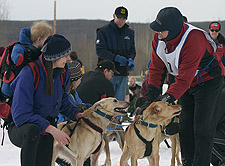
It’s worth the work
Conn loves being on the sled runners, hearing the sounds of dogs breathing and their feet on the snow, and watching the dogs move. "It’s like poetry in motion."
"I love when I’m out having great rhythm with the dogs, and the dogs are really on and we’re in synch together," Dunlap says. "I’m just out there, not even thinking that we’re in a race, and I know that we’re flying."
"Dog mushing keeps me sane in the winter," says Kaynor. "Instead of dreading the dark and cold, I look forward to snow and running the dogs."
Racing can give a musher a framework in which to run dogs. It also can serve as a yardstick for how well a training and breeding program is doing. But to some dog mushers, it’s not only about winning. "I race because the dogs love it," says Kaynor. "Racing is about having fun and the dogs having fun. A good race is one where all the dogs are pulling and happy, regardless of how we place."
For more information please contact:
- Andrea Swingley, sprint dog musher and graphic designer, University Marketing and Publications, andrea.swingley@uaf.edu, (907) 474-6397
Other useful links:
- Alaska Dog Mushers Association
- Alaska Skijoring & Pulk Association
- International Federation of Sleddog Sports
- International Sled Dog Racing Association
- Mush with P.R.I.D.E.
- Sled Dog Central
Photos © Dave Partee / SledDogStudio.com



